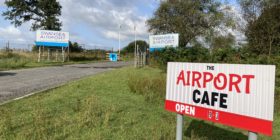Steel Horizons: Globalising The History Of A Welsh Industry

The story of steel in Wales has long had a strong international dimension: the Port Talbot works, built in the 1950s, drew on the very latest technology being used in the USA, for example. Historian Professor Louise Miskell, an expert on the steel industry in Wales, revealed this largely untold story at a free public lecture at Swansea University.
The Steel Company of Wales, formed in 1947 to build the vast new Abbey Steelworks in Port Talbot, played an important part in Britain’s economic reconstruction after the war. Led by a cohort of talented managers from engineering and financial backgrounds, it quickly gained a reputation as one of the most dynamic and outward-looking companies in the UK steel sector.
Professor Miskell’s lecture explored some of the international connections developed by the Company in the early post-war years and examine how these influenced the construction and operation of Port Talbot’s Abbey Works in the 1940s and ‘50s.
Professor Louise Miskell said:
“The history of the steel industry in post-war Britain has been dominated by the story of its relationship with the state. As the industry see-sawed between public and private ownership from the 1950s onwards there has been little attention to the role of individual companies, their managers and directors, in the process of modernisation. Global steel output tripled from 1950-1970, but we know remarkably little about how particular people and places contributed to this growth.
This is problematic not just for historians. The cultural heritage of people who live in steel-working communities past and present is impoverished because of it. Their ability to locate their place in the history of post-war steel requires recognition of the threads linking them to the industry, nationally and globally.”

Picture: a map of steel mills in the United States, brought back by Fred Cartwright, first manager of the Abbey Works in Port Talbot.
Cartwright visited the US to find out about the latest steelmaking methods. His papers, on loan from Tata Steel, are now in the Richard Burton Archives at Swansea University.
Biography – Professor Louise Miskell

Louise Miskell was born in Port Talbot and educated at St Joseph’s RC Comprehensive School in the town.
She completed her BA and PhD in History at the University of Wales Aberystwyth and went on to do postdoctoral research at the University of Dundee before joining the History Department at Swansea University in September 2000.
She has published widely on British urban and industrial history from the eighteenth to the twentieth centuries.
Her books include the co-edited volume, Victorian Dundee: Image and Realities (East Linton, 1999); Intelligent Town: an urban history of Swansea (Cardiff, 2006); Meeting Places: scientific congresses and urban identity in Victorian Britain (Farnham, 2013); and the scholarly edition, The Origins of an Industrial Region: Robert Morris and the first Swansea copperworks (Newport, 2010).
Spotted something? Got a story? Email News@News.Wales











